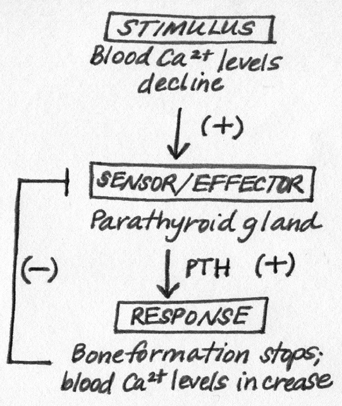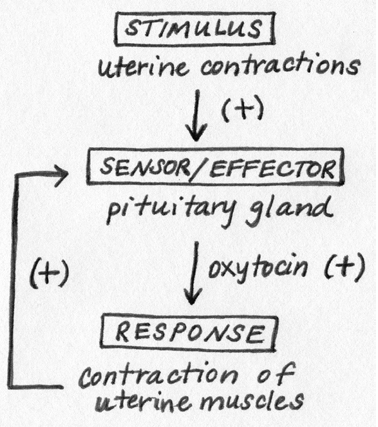CHAPTER SUMMARY
38.1 ANIMAL ENDOCRINE SYSTEMS RELEASE CHEMICAL SIGNALS CALLED HORMONES INTO THE BLOODSTREAM. THESE SIGNALS RESPOND TO THE ENVIRONMENT, REGULATE GROWTH AND DEVELOPMENT, AND MAINTAIN HOMEOSTASIS.
- The nervous system responds rapidly to sensory information, providing immediate physiological responses, whereas the endocrine system acts more slowly and over prolonged periods to affect broad changes in the physiological and behavioral state of an animal.
- The endocrine system helps an animal respond to its environment.
- The endocrine system is involved in growth and development.
- The nervous and endocrine systems regulate physiological functions to maintain homeostasis.
- Homeostasis is often achieved by negative feedback, in which the response opposes the stimulus.
- A stimulus can be amplified by positive feedback, in which the response amplifies the initial stimulus.
38.2 HORMONES ACHIEVE SPECIFICITY BY BINDING TO RECEPTORS ON OR INSIDE THEIR TARGET CELLS. THEIR SIGNALS ARE AMPLIFIED TO EXERT STRONG EFFECTS ON THEIR TARGET CELLS.
- Hormones are chemical compounds that are secreted and transported by the circulatory system, often to distant targets.
- Hormones bind to specific receptors located on the surface or inside the target cells that receive their signals.
- The three classes of hormone are peptide, amine, and steroid hormones.
- Peptide and amine hormones are hydrophilic and bind to cell membrane receptors, stimulating second messenger pathways to alter the biochemical function of target cells.
- Steroids are hydrophobic and bind to intracellular or nuclear receptors, which function as transcription factors to regulate gene expression and protein synthesis.
- Hormones communicate by signaling cascades to amplify the strength of their downstream effect on target cells.
- The hypothalamic–pituitary axis forms the central endocrine pathway by which vertebrates regulate and integrate diverse bodily functions.
- Hormones are evolutionarily conserved molecules common to diverse groups of animals, but which have evolved novel functions.
38.3 IN VERTEBRATE ANIMALS, THE HYPOTHALAMUS AND THE PITUITARY GLAND CONTROL AND INTEGRATE DIVERSE BODILY FUNCTIONS AND BEHAVIORS.
- The anterior pituitary gland secretes hormones in response to releasing factors produced and secreted by the hypothalamus.
- Hormones released by the anterior pituitary gland include thyroid-stimulating hormone (TSH), the gonadotropic hormones follicle-stimulating hormone (FSH) and luteinizing hormone (LH), adrenocorticotropic hormone (ACTH), growth hormone (GH), and prolactin.
- Tropic hormones are hormones that act on endocrine glands to produce additional hormones. TSH causes the thyroid gland to release thyroid hormones; the gonadotropic hormones FSH and LH act on the female ovaries to produce estrogen and progesterone and the male testes to produce testosterone; and ACTH acts on the adrenal gland to release cortisol.
- The posterior pituitary gland contains the axons of neurosecretory cells that release the peptide hormones oxytocin and antidiuretic hormone into the bloodstream.
- Some endocrine glands do not respond to signals from the pituitary gland. These include the parathyroid gland, which releases parathyroid hormone that helps to control calcium levels; the pancreas, which secretes insulin and glucagon to regulate blood glucose levels; and the pineal gland, which secretes melatonin in response to light and dark cycles.
38.4 CHEMICAL COMMUNICATION CAN ALSO OCCUR LOCALLY BETWEEN NEIGHBORING CELLS OR, THROUGH THE RELEASE OF PHEROMONES, BETWEEN INDIVIDUALS, COORDINATING SOCIAL INTERACTIONS.
- Paracrine signals act locally over short times to affect neighboring cells, compared to the more distant and longer-lasting signals transmitted by blood-borne hormones.
- Pheromones are chemical signals released into the air or water, signaling behavioral cues between individuals of a species.
- Sex pheromones attract mates and coordinate ritualized mating behavior; alarm pheromones signal predatory threats; trail pheromones signal the location of food sources; and territorial pheromones signal a male’s dominance and breeding area.
Self-Assessment Question 1
Describe three general functions of the endocrine system and provide an example of each.
Show Model Answer
Model Answer:
The endocrine system works to (1) regulate growth and development (e.g., coordinating caterpillar molting and metamorphosis); (2) maintain homeostasis (e.g., balancing blood-glucose levels); and (3) allow for response to environmental changes (e.g., preparing an animal to flee at the sight of a predator).
Self-Assessment Question 2
Diagram an endocrine pathway, such as parathyroid regulation of blood calcium levels, that maintains homeostasis of a bodily function by means of negative feedback.
Show Model Answer
Model Answer:

Self-Assessment Question 3
Diagram an endocrine pathway, such as oxytocin regulation of female labor during birth, that relies on positive feedback.
Show Model Answer
Model Answer:

Self-Assessment Question 4
Identify and provide an example of each of the three general classes of hormone.
Show Model Answer
Model Answer:
Hormones can be amines (e.g., epinephrine), peptides (e.g., oxytocin), or steroids (e.g., cortisol).
Self-Assessment Question 5
Explain how hormones act specifically on only some cells or organs despite being transported by the bloodstream throughout the body.
Show Model Answer
Model Answer:
Hormones must bind to specific receptors in order to exert an effect on a cell, so only those cells or organs that express the specific receptor for a given hormone will respond to the hormone as it passes through the blood.
Self-Assessment Question 6
Describe how hormones exert substantial and broad effects on their target cells despite being released in small amounts by the initial signaling gland.
Show Model Answer
Model Answer:
The endocrine system can elicit broad and dramatic effects throughout the body because the initial hormone signal is amplified at several different steps along the pathway. If the initial hormone targets an endocrine gland, the gland will release an amount of its specific hormone that is larger than the amount of the initial hormone originally released. When a hormone reaches a target cell, the signal is again amplified within the cell. This occurs through signaling cascades in a signal transduction pathway. In signaling cascades, each individual molecule in the pathway may activate one or more downstream molecules, such as an enzyme.
Self-Assessment Question 7
Explain how peptide hormones affect the function of a target cell.
Show Model Answer
Model Answer:
Peptide hormones are hydrophilic, so their receptors are located at the surface of the cell because these hormones cannot readily cross the plasma membrane. Once a peptide hormone binds to its receptor at the cell surface, intracellular second messenger pathways are activated. Ultimately these hormones affect the activity of one or more enzymes within the cell and lead to changes in gene expression, cell growth and metabolism, or hormone release, on timescales of minutes to hours.
Self-Assessment Question 8
Explain how steroid hormones affect the function of a target cell.
Show Model Answer
Model Answer:
Since steroid hormones are hydrophobic and can cross the plasma membrane, their receptors are located within the cell. Once a steroid hormone binds to its receptor, this activated complex can function as a transcription factor in the nucleus to alter gene expression. In this way, these hormones modulate the function, metabolism, or activity of the cell in a wide variety of ways over the span of days to months.
Self-Assessment Question 9
Explain the difference between the way in which the hypothalamus controls the anterior pituitary gland and the way it controls the posterior pituitary gland.
Show Model Answer
Model Answer:
The hypothalamus controls the posterior pituitary gland directly by way of neurosecretory cells. The cell bodies of these cells are located in the hypothalamus and their axons terminate in the posterior pituitary. Instead of releasing neurotransmitters, these axons release hormones via the posterior pituitary straight into the blood. The anterior pituitary gland is controlled by hormones, known as releasing factors. These releasing factors are released by other neurosecretory cells of the hypothalamus and travel via small blood vessels to the anterior pituitary. The releasing factors then stimulate the release of hormones from the anterior pituitary into the bloodstream.
Self-Assessment Question 10
Explain the difference in action between a hormone, a paracrine signal, a neurotransmitter, and a pheromone.
Show Model Answer
Model Answer:
Hormones can elicit broad and coordinated changes within specific organs or an entire organism because they can travel long distances throughout the body via the bloodstream. Paracrine signals are not transported in the blood; they act locally to modulate the behavior of neighboring cells. Neurotransmitters act over short distances to allow rapid communication between adjacent neurons. They also act between neurons and muscles to mediate motor outputs necessary for movement and body control. Pheromones are released into the environment; they can act at great distances to affect the behavior of other animals.